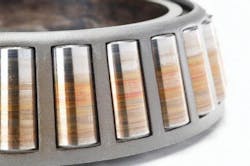Beware the Four Levels of Inadequate Bearing Lubrication
By Kuldeep Mistry, Ph.D., research and development specialist, The Timken Company
Bearings work in tough operating conditions that are only getting tougher. As OEMs and heavy equipment operators demand more from their machines, bearings are being asked to operate at higher speeds and temperatures under greater loads. Increasingly, proper lubrication practices are critical to avoiding bearing damage that can lead to lost production time.
Most bearings?some 80 to 90%?use grease as a lubricant, and most bearing damage is caused by inadequate lubrication, where an insufficient amount of grease separates the rolling and sliding contact surfaces during service. This can result in progressive levels of bearing damage and mounting risk to safe and efficient operations.
The following outlines the progressive levels of damage that can be caused by inadequate lubrication. When inspecting and servicing bearings, be sure to look for these warning signs before bigger problems occur.
Level 1: Discoloration
Metal-to-metal contact can result in excessive bearing temperatures, causing discoloration of the races and the roller. In mild cases, this discoloration is due to the lubricant staining the bearing surfaces, while in severe cases the metal is discolored from high heat. In all cases, early detection can prevent costly repairs.
Level 2: Scoring and Peeling
Inspect bearings for marks cut into the metal or the metal peeling away?these conditions require immediate attention. Scoring and peeling tend to occur in high-load/low-speed applications or where high temperatures are persistent. Thin or inadequate lubricant film conditions will only accelerate the problem.
Level 3: Excessive Roller End Heat
Localized scoring can occur due to the breakdown of the lubricating film and results in the direct contact between components. In tapered roller bearings, this can manifest as scoring on the large end of the roller and the guiding rib of the rings.
Level 4: Total Bearing Lockup
Extreme localized heat can produce metal flow in bearings, altering the original bearing geometry and material. This may cause excessive roller skewing, destruction of the cage and/or complete seizure of the bearing. If catastrophic damage does occur, it is advisable to consult a bearing expert who can determine the root cause of the problem that may extend to factors beyond lubrication.
The damage caused by inadequate lubrication varies greatly in both appearance and impact on bearing performance. In all scenarios, it is important that the grease amount, type, grade, viscosity, additives, and supply system be properly engineered for the bearing system. Grease selection should be based on history, loading, speeds, sealing systems, service conditions and expected life. Without proper consideration of these factors, less than expected bearing and application performance are likely.
That is where the knowledge and precision of a lubrication expert can come into play. Look for a partner well-versed in material science and tribology that can analyze bearing damage and determine the optimal grease for an application. Or if you simply need help setting new lubrication guidelines, there are experienced pros who can work with you to develop a program and in-depth training.
It’s a tough world for bearings, but improved lubrication practices can help businesses roll forward more smoothly. Take extra time and care when inspecting bearings, and do not hesitate to call on an expert if excessive friction is holding your operation back.
Learn more about ensuring productivity and uptime with bearing lubrication solutions.




